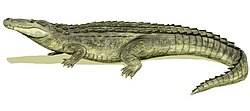| Albertochampsa Temporal range: | |
|---|---|
 | |
| Skull at the Yale Peabody Museum | |
| Scientific classification | |
| Kingdom: | Animalia |
| Phylum: | Chordata |
| Class: | Reptilia |
| Clade: | Archosauria |
| Order: | Crocodilia |
| Superfamily: | Alligatoroidea |
| Family: | Alligatoridae |
| Genus: | † Albertochampsa Erickson, 1972 |
| Type species | |
| †Albertochampsa langstoni Erickson, 1972 | |
Albertochampsa is an extinct genus of alligatorid (possibly a stem-caiman [1] or a basal alligatorine [2] ) from the Late Cretaceous of Alberta. It was named in 1972 by Bruce Erickson, and the type species is A. langstoni. [3] It is known from a skull from the Campanian-age Dinosaur Park Formation, where it was rare; Leidyosuchus is the most commonly found crocodilian at the Park. The skull of Albertochampsa was only about 21 cm long (8.3 in). [4]


